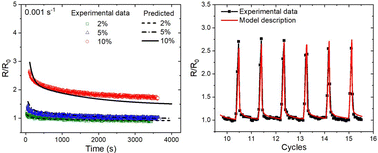Modeling the resistive viscoelasticity of conductive polymer composites for sensor usage†
Abstract
With the development of fully printed electronics, soft sensors are in demand in various fields, such as wearable electronics, soft machines, etc. Most soft resistive sensors are made of conductive elements dispersed in a viscoelastic polymer binder, exhibiting resistive viscoelastic behavior. The resistance of soft resistive sensors is time-dependent due to the viscoelastic response of polymer binder and structural rearrangement of the conductive pathway. In this paper, experiments and theoretical modeling are used to study the resistive viscoelastic behavior of printed silver wires. The printed silver wire belongs to conductive polymer composites (CPCs) consisting of conductive silver-nanoparticle pathways in an elastic polymer binder. Based on tunneling theory, a multi-branch model is developed to capture the resistance variation of the printed silver wire under mechanical loading. Our experiment-validated model uses only a single set of parameters to predict the resistive relaxation behaviors of CPCs under different strain and different loading rates. Moreover, we demonstrated this numerical model could describe the resistance response under complex loading conditions, such as cyclic loading, similar to the sensor's working condition. The multi-branch model can be extended to any other soft resistive sensor, such as a strain sensor, and provide a new avenue to calibrate these soft sensors.



 Please wait while we load your content...
Please wait while we load your content...